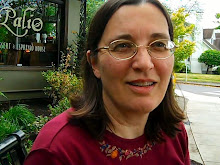I've been Orthodox 14 years this Pascha, but I've spent my life in a remote backwater of the Orthodox world and have never been to see a pilgrim icon. The Stroganoff Exhibit at the Portland Art Museum doesn't count, because at an art museum, you look at art; you don't interact with the the saints. So the whole idea of going to see an icon, as if it were a visiting theologian, is remote from my experience, though in my head I understand it.
![]() The central figures in the icon are the Theotokos (the Virgin Mary) and Jesus. That configuration is called The Lady of the Sign because it emphasizes the miracle of Christ's Incarnation, harkens back to "A Virgin shall bear a Son, Emmanuel," points to the hymnography asking, "How can you bear your Creator in your womb?" and illustrates that Mary kept Jesus in her heart, in the sense that Evangelicals use that expression. The surrounding figues are of Old Testament prophets, and the one at the top, I fear, is an image of God the Father. Church canons forbid making images of the Father, because He can't be seen, but sometimes people's devotion outstrips their attention to Church canons.
The central figures in the icon are the Theotokos (the Virgin Mary) and Jesus. That configuration is called The Lady of the Sign because it emphasizes the miracle of Christ's Incarnation, harkens back to "A Virgin shall bear a Son, Emmanuel," points to the hymnography asking, "How can you bear your Creator in your womb?" and illustrates that Mary kept Jesus in her heart, in the sense that Evangelicals use that expression. The surrounding figues are of Old Testament prophets, and the one at the top, I fear, is an image of God the Father. Church canons forbid making images of the Father, because He can't be seen, but sometimes people's devotion outstrips their attention to Church canons.
The covering of gold and silver was added centuries after the icon was found in 1295 at the root of a tree near Kursk, Russia, during the Tatar invasions.
Here is a detailed history of the icon. I don't know if this one dates from 1295 or if it's one of the copies made and lost over the centuries. That's a detail that matters more to art dealers than to Orthodox Christians. For example, there's a story of a Russian woman who went to a famous holy spring to bring water for her sick friend (or mother or someone). Along the way, she gave the water to a thirsty beggar and refilled the bottle from another source. The friend recovered, even though it wasn't the "original" water.
The Kursk Root Icon of Our Lady of the Sign has been in the Russian disaspora since the Russian Revolution, traveling from place to place around America and elsewhere. It seems to be on a last "tour" of the United States, before it's returned to Riga, Latvia.
 If the truth be told, though, I'm happy at my own parish, with this icon (12 feet in diameter), by very much contemporary Heather MacKean, above my head and my own community around me.
If the truth be told, though, I'm happy at my own parish, with this icon (12 feet in diameter), by very much contemporary Heather MacKean, above my head and my own community around me.
UPDATE: Fellow Orthoblogger Karl took advantage of an opportunity to venerate the Kursk Root icon when it came to Oregon. He says, "Miracle working icons are a pledge, a sign of that which is both already in our midst but also yet to come--the total transfiguration and recreation of everything in Christ."

No comments:
Post a Comment